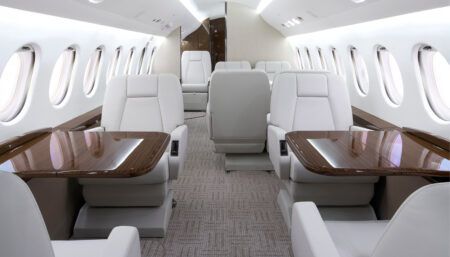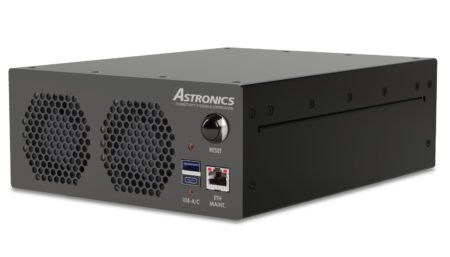Jan Grube of Lufthansa Technik details some of the standout features of the Explorer cabin design for VIP wide-body aircraft
How have you adapted Diehl’s projection technology to work in this design?
Our goal was to develop a multifunctional VIP cabin concept with a completely new lining, which provides an optimal – and as large as possible – projection surface for a variety of virtual content. Therefore, the required environment for Diehl’s projection system had to be optimised from both a technical and aesthetic point of view.
We put strong emphasis on designing a concept that was technically feasible. For example, all the essential functions of a cabin – such as oxygen masks, reading and spotlights – had to be positioned in such a way that there were no cut-outs in the projection surfaces. We therefore made a clear distinction between projection zones and function zones, right from the start.
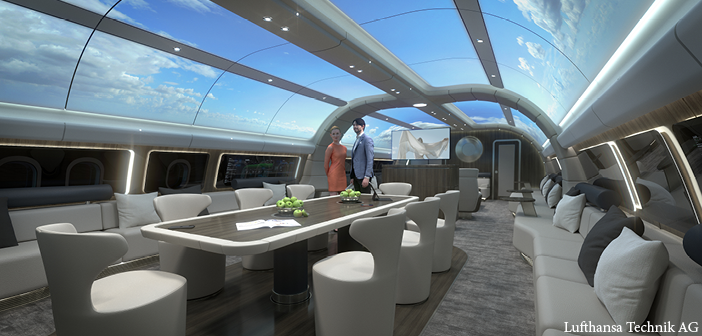
It was important to ensure optimal projection angles and optimal distances between projectors and projection surfaces, and to ensure that all projection surfaces are completely covered by the projection beam. All of this significantly influences the geometries of the overall design.
In addition, we wanted the cabin to be equipped with indirect base lighting that is independent of the projection system and that supports and complements the projections rather than interfering with or outshining/overpowering them. However, this basic lighting should also provide independent, pleasant and atmospheric illumination of the cabin, even when the projectors are completely switched off.
All this consequently led to the – at first perhaps counterintuitive – arrangement of the projection surfaces. They actually protrude slightly into the room and are not (as one might expect) located behind a layer separating the physical interior from the virtual exterior. This allows a combination with a base illumination behind them.
For further optimisation, large divan areas were created in front of the window belts, for example. On the one hand, they serve the comfort of the guests, but on the other hand, they also guarantee the passengers’ distance from the projection beams, so that no disturbing shadows are created on the projection surfaces.
In addition to this spatial optimisation for Diehl’s projection system, general analyses of visual contexts within the overall ‘explorers and adventures’ theme also played a role in our design, for example points of contact on and under the surface of the water, in open terrain or in aerospace. A few of these have been integrated into the design in such a way that – used in a discreet manner – they provide an adequate framework for a maximum number of different projection themes. For this purpose, numerous projection ideas were investigated that go far beyond what is shown so far and even reach into the areas of crypto-art and gaming.
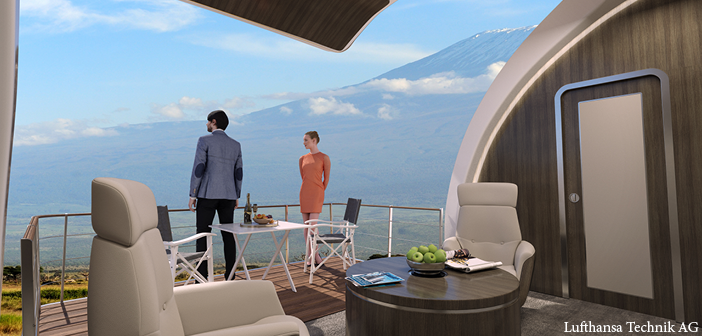
Are there any challenges involved in the incorporation of the veranda?
The full structural design engineering and respective stress analysis to finally build and certify such a veranda is, of course, an immensely detailed work package that we would only tackle once the veranda has finally been selected for a real customer cabin project, with the respective funding. Nevertheless, to be able to show such a design feature in this concept, we have already conducted a thorough review in terms of engineering judgements on the main-deck cargo door and the necessary modifications involving the aircraft floor structure. In this analysis, we could rely on our extensive experience with aircraft modifications of all kinds. The outcome was that such a veranda is indeed technically feasible, and it would not affect the operation of the aircraft.
The main-deck cargo door required for the veranda could, for example, be sourced by using a new-build freighter aircraft such as the B767F, B777F or A330F. However, these aircraft lack conventional cabin windows, which we expect to still be in demand with our customers, despite the large-scale virtual windows. The more suitable option might thus be to retrofit the cargo door into a new or used passenger aircraft. For several wide-body aircraft types (for example, the A330, B767 and B777) such retrofit programmes are already available in the market. Only the most modern wide-body aircraft with composite fuselages lack line-fit (B787) or retrofit (B787 and A350) solutions for main-deck cargo doors at the moment.
What are the challenges in implementing the Brabus Mobility Lounge?
Although this feature will not be fully detailed before one of the coming air shows, we indeed already expect some challenges in this area. First, the respective area in the cargo hold will need to be specially equipped to allow passenger/crew access during flight. Here, we plan to build on existing solutions for crew-rest areas in the lower deck that already incorporate certified solutions for staircases and cargo access hatches.
On top of that, we expect some more complex modifications and adaptations to systems like the environmental control system or safety equipment such as the emergency oxygen supply, lighting, communications, and more.
Another focus in designing the mobility aspect will be ensuring the safe transport of equipment of any kind. Here, for example, we will have to adhere to the existing features and procedures for transporting cargo on board such aircraft. The respective safe latching of the equipment or vehicles will be one key prerequisite, for example.
Would you like to go into some of the project’s other features and design details?
To fully experience the projection system’s discotheque theme, tables and chairs in the multifunctional lounge area can be removed and stowed away, making room for a fully fledged dance floor. The furniture mountings will retract seamlessly into the cabin floor while the tabletop and chairs will need to be stowed away manually by the crew.
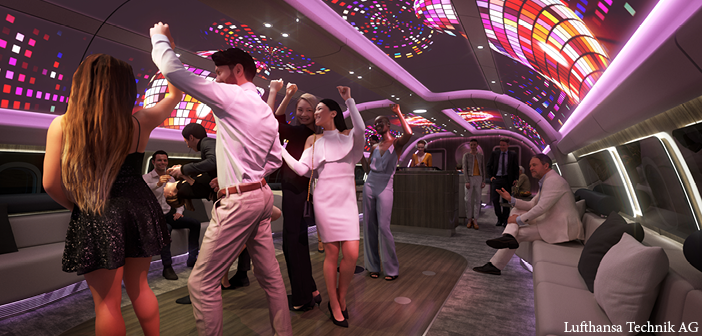
Another highlight in our eyes is the multifunctional wellness/spa/gym area in the rear of the cabin, which, for example, features a sauna and a steam shower. In a medical emergency, this area can be transformed quickly into a flying hospital room. Besides the steam shower, the current Explorer layout features a total of six conventional showers.
Moreover, the aircraft is equipped with a gourmet galley in the front of the cabin that will be able to cater to the highest culinary requirements of the 8-12 passengers.
Catering to the need for the best possible hygiene, an aircraft such as this can also be equipped with upgraded filtration systems for cabin air and/or self-disinfecting surfaces.
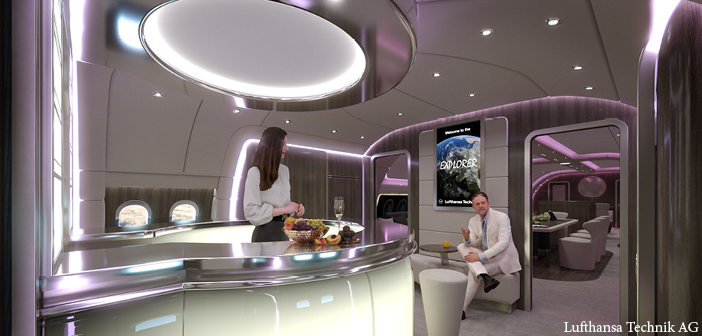
What’s next for the project?
The next milestone for Explorer will be to finalise the design of the Mobility Lounge in the lower deck. Together with carmaker Brabus, we have already developed some cool ideas that we will detail in the coming months and show at one of the upcoming airshows. The range of ideas we already have even goes a bit beyond the mobility aspect. Please stay tuned.
As charter agencies for such aircraft may have the demand for more passengers, we also plan to release a cabin layout that allows 40 or more passengers on board, while keeping the Explorer concept idea.
Moreover, we plan to use the Explorer concept as sort of an idea laboratory, based on which we will discuss and present a number of other ideas for VIP cabin designs and features in the future.
Jan Grube is sales director for VIP & Special Mission Aircraft Services at Lufthansa Technik. Parts of this interview were first published as part of the Design Brief in the January 2022 edition of Business Jet Interiors International.
Images: Lufthansa Technik AG



